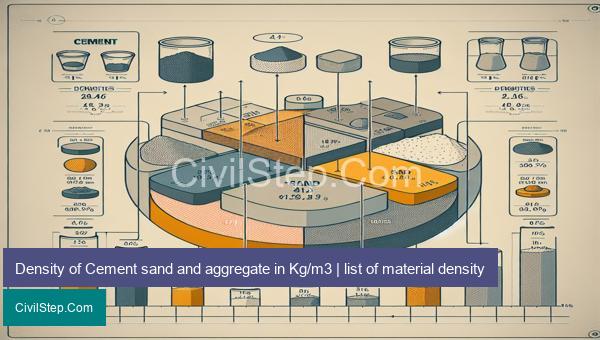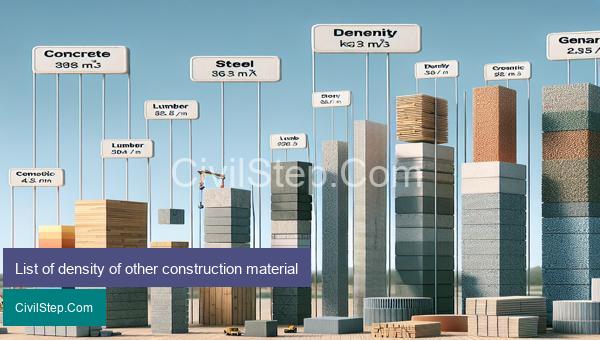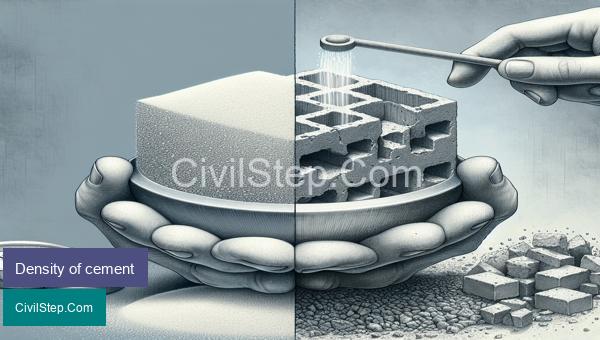
The density of materials used in construction is one of the most crucial factors to consider when designing and building structures. Cement, sand, and aggregate are three fundamental materials that are commonly used in construction projects, and their density plays a vital role in determining the strength and stability of a structure. In this article, we will delve into the world of construction materials and explore the density of cement, sand, and aggregate, measured in kilograms per cubic meter (Kg/m3). Additionally, we will provide a comprehensive list of material density for various commonly used construction materials. Understanding the density of these materials is essential for engineers, architects, and construction professionals to ensure the successful completion of any building project. Whether you are a student, a professional, or someone
Density of sand

Density of sand refers to the measurement of how much mass is contained in a certain volume of sand. It is an important physical property of sand and is commonly used in construction and geotechnical engineering.
The density of sand can vary based on various factors such as the type of sand, the particle size distribution, and the moisture content. However, on average, the density of sand is around 2,600 kg/m³ (160 lb/ft³). This means that for a volume of 1 cubic meter, the mass of sand would be 2,600 kilograms.
As mentioned, the type of sand greatly affects its density. Fine-grained sand particles have a higher density compared to coarse-grained sands. This is because fine-grained sands have smaller pores and the particles are tightly packed together, resulting in a higher mass per unit volume.
Moisture content is another factor that affects the density of sand. Dry sands have a higher density compared to wet sands as the moisture occupies some space between the sand particles, reducing their density. This is why engineers often specify the moisture content of sand when conducting laboratory tests and compaction tests on soil.
The density of sand also plays a crucial role in determining its suitability for various construction applications. In general, sands with higher densities are preferred for filling and compacting purposes, such as embankments, foundation layers, and backfill material. This is because they can withstand higher loads and have better stability.
In addition to construction, the density of sand is also important in geotechnical engineering. For soil analysis and design calculations, it is necessary to know the density of sand in order to determine its bearing capacity, shear strength, and other important parameters.
To measure the density of sand, several methods can be used. The most common method is the bulk density test, where a known volume of sand is weighed and its mass is divided by the volume. Another method is the liquid density test, where the density of sand is measured by immersing it in a liquid and comparing its weight.
In conclusion, the density of sand is an essential property that affects its behaviors and applications in construction and geotechnical engineering. As a civil engineer, understanding the density of sand is crucial in selecting the right type of sand for different projects and ensuring their structural integrity and stability.
List of density of other construction material

Density is a measurement of mass per unit volume, representing how closely packed the molecules are in a substance. In the field of construction, the density of materials is an important factor to consider as it affects the overall weight and strength of a structure. Here is a list of some common construction materials and their corresponding densities:
1. Concrete: Concrete is a widely used building material composed of aggregate (such as gravel or crushed stone), cement, and water. Its density can range from 1400 to 2400 kg/m3, depending on the type and composition of aggregate used.
2. Steel: Steel is a versatile construction material known for its high strength and durability. Its density is approximately 7850 kg/m3, making it one of the heaviest construction materials.
3. Timber: Timber, also known as wood, is a renewable and lightweight construction material. The density of timber can vary from 300 to 800 kg/m3, depending on the species and moisture content.
4. Brick: Bricks are made of clay and are commonly used for building walls and foundations. The density of a brick can range from 1500 to 2000 kg/m3, depending on its size and porosity.
5. Glass: Glass is a transparent material used for windows, doors, and facades. Its density can range from 2200 to 2900 kg/m3, depending on the type and thickness of glass.
6. Asphalt: Asphalt is a common paving material used in roads, parking lots, and driveways. Its density can range from 2200 to 2600 kg/m3, depending on the type and composition of the asphalt mix.
7. Gypsum: Gypsum is a building material used for plaster and drywall. Its density can range from 700 to 1000 kg/m3, depending on the type and moisture content.
8. Insulation materials: Insulation materials, such as polystyrene and mineral wool, are used to regulate temperature and reduce energy consumption in buildings. Their densities can range from 10 to 50 kg/m3.
9. Aluminum: Aluminum is a lightweight and corrosion-resistant metal used in construction for its strength and flexibility. Its density is approximately 2700 kg/m3.
10. Concrete block: Concrete blocks are commonly used in building walls and partitions. Their density can range from 1800 to 2200 kg/m3, depending on their size and composition.
It is essential to consider the density of construction materials during the design and construction phases to ensure the structural integrity and stability of a building. The density of materials also affects their durability, insulation properties, and overall cost. Therefore, understanding the density of different construction materials is crucial for achieving safe and efficient construction practices.
Density of cement

Density of cement refers to the measure of how heavy a certain amount of cement is compared to its volume. Cement is a crucial component in construction as it is used as a binding material in concrete, mortar, and other building materials. The density of cement is an important parameter that affects many properties of concrete, such as its strength, durability, and workability.
The density of cement can vary depending on the type of cement and its manufacturing process. Generally, the density of cement ranges from 1100 kg/cubic meter (1.1 g/cm3) to 1600 kg/cubic meter (1.6 g/cm3). However, the most commonly used cement type, Portland cement, has an average density of around 1440 kg/cubic meter (1.44 g/cm3).
The high density of cement can be attributed to its fine particles, which are smaller than 45 microns. These fine particles are tightly packed together, resulting in a high density. The presence of water in cement paste also contributes to its density. Cement paste is a mixture of cement, water, and any added admixtures, and it has a density of about 2000 kg/cubic meter (2 g/cm3).
The density of cement can also vary depending on its moisture content. If the cement is stored in a moist environment, it can absorb water and increase in density. This can lead to issues in concrete, as it can result in a higher water-cement ratio, affecting its strength and durability.
The density of cement also plays a significant role in determining the volume of concrete produced. The volume of concrete is calculated by multiplying the density of cement by its weight. Accurately calculating the volume of concrete is essential in construction to ensure correct proportions of materials and to avoid any over or underestimation of materials.
In conclusion, the density of cement is a crucial factor that impacts the properties and performance of concrete. As a civil engineer, it is essential to understand the concept of density and its effects on cement and concrete. Careful consideration should be given to the density of cement when designing and constructing structures, as it can greatly affect the quality and durability of the final product.
Density of cement mortar

Density of cement mortar refers to the mass per unit volume of the mixture of cement, sand, and water used for various construction purposes. It is an important factor that determines the strength and durability of the mortar. The density of cement mortar varies depending on the proportion of materials used and the water-cement ratio.
The density of cement mortar can range from 2000 to 2300 kg/m3. This variation is due to the different types of cement and the amount of water present in the mixture. Portland cement is the most commonly used cement in mortar, and it has a density of 1440 kg/m3. However, the density of the final mortar mix also depends on the specific gravity of sand, which ranges from 1.6 to 2.5.
The density of cement mortar is an important parameter that affects its compressive and flexural strength. A higher density results in stronger and more durable mortar. This is because a higher density means more cement and less voids in the mortar mix, leading to better bonding between the particles. Lower density mortars are prone to cracking and have poor load-bearing capacity.
To achieve a desired density, the water-cement ratio must be carefully controlled. As the amount of water increases, the density of the mortar decreases. Excessive water in the mix can lead to the formation of pores, reducing the density and weakening the mortar. On the other hand, a mortar with low water-cement ratio produces a dense and strong mix.
The density of cement mortar also affects its workability. A high-density mortar is difficult to spread and requires more effort to apply. On the contrary, a low-density mortar is easier to handle, but its strength and durability may be compromised. Various techniques, such as adjusting the amount of water and using admixtures, can be employed to achieve both the desired density and workability of the mortar.
In conclusion, the density of cement mortar plays a crucial role in determining its quality and performance. Generally, a denser mortar is preferable for structural applications, while a lower density may be suitable for non-load-bearing applications. Proper proportioning and control of the water-cement ratio are essential to achieve the desired density and maintain the strength and durability of the mortar.
Density of cement concrete

Density is defined as the mass per unit volume of a substance, and it is an important material property in civil engineering. In the construction industry, concrete is one of the most commonly used materials, and its density plays a crucial role in determining the strength and durability of structures. The density of cement concrete is an essential parameter that needs to be carefully considered in the design and construction of buildings, roads, bridges, and other structures.
Cement concrete is a composite material composed of cement, aggregates (such as sand and gravel), and water. The cement in concrete acts as a binder, holding the other ingredients together. When mixed with water, cement undergoes a chemical reaction known as hydration, which forms a paste-like substance that hardens and binds the aggregate particles together. The resulting hardened material, also known as concrete, has high compressive strength and is widely used in construction projects.
The density of cement concrete can vary depending on the composition of its ingredients, water-cement ratio, and the degree of compaction. On average, the density of ordinary concrete ranges from 2300 to 2500 kg/m3. However, it can go up to 3000 kg/m3 for heavy concretes used in bridges and other infrastructure projects. The density of lightweight concrete, on the other hand, can be as low as 500 to 2000 kg/m3.
The high-density range of concrete is achieved by using heavy aggregates such as iron ore, magnetite, steel shot, and barite instead of traditional aggregates. Lighter aggregates, such as expanded clay, shale, or slate, are used in lightweight concrete to reduce its weight and increase its insulation properties. These lightweight aggregates also reduce the overall density of concrete, making it more economical.
The density of cement concrete has significant implications in its behavior and performance. A higher density concrete has a lower porosity and is more durable. This is because a denser concrete has fewer voids or air pockets, reducing the likelihood of water, chemicals, or other detrimental agents from penetrating and damaging the concrete. In contrast, lightweight concrete has a higher porosity, making it more susceptible to damage from external factors.
In conclusion, the density of cement concrete is a key factor in its design and construction. Civil engineers must carefully consider the density of concrete in their projects to ensure optimal strength, durability, and performance. Properly proportioning the mix, selecting appropriate aggregates, and using proper compaction techniques are all critical in achieving the desired density of concrete for a project.
Density of sand in kg/m3

Density is a physical property of a material that describes its mass per unit volume. The density of a substance is typically expressed in kilograms per cubic meter (kg/m3) in the SI system of units. In civil engineering, density is an important factor to consider when dealing with the design and construction of structures, as it affects the strength and stability of materials in various applications.
Sand is a commonly used construction material in civil engineering projects, such as in building foundations, pavement construction, and soil stabilization. It is a loose granular material composed of small particles of minerals and rock fragments. The density of sand varies depending on its origin, composition, and moisture content. The range of densities for different types of sand can be between 1442 to 2300 kg/m3.
Generally, the density of sand is higher than most soils, which makes it a preferred material for use in construction. The density of sand can be affected by several factors, such as compaction, angularity of particles, and particle size distribution, among others. Factors like moisture content, shape and surface area of sand particles, and the presence of impurities can also influence the density of sand.
The standard density of sand used in civil engineering is 1600 kg/m3. This is the density of dry sand with no moisture content. However, the density of sand can vary based on the moisture content, and it increases with the increase in moisture content. For instance, the density of damp sand (with 5% moisture content) can be around 1700 kg/m3, whereas the density of saturated sand (with maximum moisture content) can be as high as 2300 kg/m3.
Sand is usually loosely packed, which means that the interparticle spaces are filled with air. When sand is compacted, the air is removed, and the particles become tightly packed, resulting in an increase in density. The compaction process also eliminates voids between particles, making the sand denser and improving its load-bearing capacity.
In conclusion, the density of sand varies, depending on factors such as its origin, composition, and moisture content. The density of sand can range from 1442 to 2300 kg/m3, with the standard density used in civil engineering being 1600 kg/m3. Understanding the density of sand is crucial in civil engineering for proper calculation of material quantities and ensuring the stability and strength of structures.
Density of aggregate (coarse sand)/ gravel

Density is a measure of how much mass is contained in a given volume of a substance. In the field of civil engineering, density plays a crucial role in the design and construction of structures. It is particularly important when it comes to the selection of construction materials such as aggregates.
Aggregates are commonly used in the construction industry to produce concrete and asphalt. They provide structural stability and contribute to the overall strength of the finished product. There are different types of aggregates, such as sand, gravel, and crushed stone, which vary in size and shape.
Density of aggregate refers to the mass of the aggregate per unit volume. It is usually expressed in kilograms per cubic meter (kg/m3) in the metric system and pounds per cubic foot (lb/ft3) in the imperial system. In general, aggregates with higher density are better for construction purposes as they provide better strength and durability to the structures.
When it comes to coarse sand and gravel, their density varies depending on the source and the size of the particles. Coarse sand has a density ranging from 1450 – 1800 kg/m3 while gravel has a density of 1500 – 2300 kg/m3. This means that for the same volume, gravel will be heavier than sand.
The density of coarse sand and gravel also depends on the degree of compaction. Compaction is the process of reducing the volume of the aggregate by removing the air voids. This is usually achieved by using heavy equipment or by applying pressure during the construction process. The more compacted the aggregate is, the higher its density will be.
It is important to note that the density of aggregate can significantly affect other properties such as workability and water absorption. Workability refers to the ease of mixing and placing the concrete. The more dense the aggregate, the more difficult it will be to work with. On the other hand, water absorption refers to the amount of water that the aggregate can retain. A higher density aggregate will have lower water absorption, which is desirable in construction.
In conclusion, as a civil engineer, understanding the density of aggregate is essential in selecting the right material for construction projects. It is crucial to consider the type of aggregate, its source, and the degree of compaction in order to determine the optimal density for a specific project. A balance between density and other properties such as workability and water absorption should be carefully considered to ensure the best results.
Density of aggregate in kg/m3

Density of aggregate is a critical factor in the construction industry as it plays a significant role in determining the strength, durability, and overall quality of a structure. It is a fundamental physical property of aggregates that refers to the mass per unit volume of materials.
In simple terms, density is the measure of how closely packed the particles of an aggregate are. It is expressed in units of mass per unit volume, typically in kilograms per cubic meter (kg/m3) in the metric system and pounds per cubic foot (lb/ft3) in the imperial system. Density is often used interchangeably with specific gravity, which is a dimensionless quantity representing the ratio of the density of a material to the density of water.
The density of aggregate varies depending on the type of material and its source. Generally, aggregates with a high density have a higher strength and are more resistant to abrasion, erosion, and weathering. The density of an aggregate can also affect the workability, pumpability, and flowability of concrete, making it a crucial factor to be considered in construction projects.
The density of natural aggregates such as sand, gravel, and crushed stone ranges from 1520 to 1680 kg/m3. Meanwhile, artificial aggregates like expanded clay, shale, and slag can have densities as low as 400 kg/m3 and as high as 1900 kg/m3. The density of recycled aggregates, which are becoming more popular in construction, typically ranges from 800 to 1600 kg/m3.
The grading and particle size distribution of an aggregate affect its density. Coarse aggregates have lower densities compared to fine aggregates, as they have more voids between the particles. Moreover, the specific gravity and moisture content of an aggregate can also influence its density. Aggregates with high specific gravity, such as magnetite and barite, tend to have higher densities.
The density of aggregate is measured by filling a known volume (usually a cylindrical container) with the aggregate and then weighing it. The calculation of density is then done by dividing the mass of the aggregate by its volume. It is essential to take multiple measurements to obtain an accurate average density of the aggregate.
In conclusion, the density of aggregate is an essential factor to consider in construction. It is integral in the design of concrete and other construction materials, as well as in the evaluation of their quality and performance. The density of aggregate can vary greatly, so it is crucial to determine the specific density of the aggregate being used in a particular project to ensure optimal results.
Density of coarse aggregate

Density of coarse aggregate refers to the mass of the individual particles that make up the aggregate per unit volume. It is an important parameter for the design of concrete mixtures and is determined by various factors such as the size, shape, and specific gravity of the particles.
The coarse aggregate used in concrete is typically composed of crushed rock, gravel, or stone. Depending on the source, it can also contain materials such as sandstone and granite. The size of coarse aggregate can vary from 5mm to 20mm depending on the type of construction and its requirements.
The density of coarse aggregate is affected by various factors such as moisture content, compaction, and grading. A higher density is generally preferred in concrete as it leads to a stronger and more durable mixture. The density also influences the workability of concrete and its ability to resist segregation or settlement during transportation and placement.
The density of coarse aggregate can be divided into two categories – loose and compacted. Loose density refers to the natural state of aggregate where there is no compaction or settling. Compacted density, on the other hand, is achieved by compacting the aggregate particles in a specified manner. This is done by using standard methods such as rodding or tamping to obtain a uniform and consistent density.
The density of coarse aggregate is expressed in kilograms per cubic meter (kg/m3) or pounds per cubic foot (lb/ft3). The typical range for loose density of coarse aggregate is 1350 to 1750 kg/m3 (84 to 110 lb/ft3), while compacted density can range from 1500 to 1900 kg/m3 (94 to 118 lb/ft3).
In order to achieve the desired density of coarse aggregate, it is important to use the correct proportion of materials and follow proper mixing and compaction techniques. The use of lightweight aggregates can also significantly affect the density of coarse aggregate, leading to a decrease in the overall weight of concrete. This is especially useful in structures where weight is a critical factor.
In conclusion, the density of coarse aggregate plays a crucial role in determining the strength, durability, and workability of concrete. Proper selection and handling of coarse aggregate is important to ensure the desired density and quality of the final concrete mixture.
Conclusion
In conclusion, understanding the density of cement, sand, and aggregate is crucial in construction and structural engineering. These materials play a significant role in determining the strength and durability of concrete structures. By knowing the density of these components, engineers and builders can accurately calculate the required amount of each material for a specific project. The density of cement, sand, and aggregate can vary based on factors such as particle size, moisture content, and compaction. Therefore, it is essential to use accurate and updated density values when working with these materials. With the list of material density provided, professionals can easily refer to it for quick and reliable information. By paying attention to the density of these materials, the overall quality and longevity of construction projects can be greatly improved.
